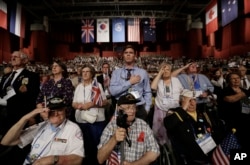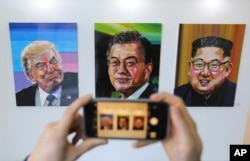As speculation focuses on the possibility that President Donald Trump may declare peace, and end the Korea War at his second summit with North Korean leader Kim Jong Un, experts see such as move as a possible trade off for Pyongyang’s denuclearization.
“We want denuclearization,” Trump said on Monday before leaving for Hanoi to meet with Kim on Feb. 27 and 28. “And I think he’ll have a country that will set a lot of records for speed in terms of an economy.”
The leaders first met in Singapore in June, a summit widely criticized for the lack of concrete progress. They signed a four-point document calling for new relations between their two countries, peace on the peninsula, denuclearization and the recovery of remains of American servicepersons killed or missing in North Korea.
Trump’s remarks on Monday came as the White House released a statement on Thursday calling for “a push for peace” saying that Trump is committed to achieving “transformational peace” for the Korean Peninsula with a possible consideration of economic inducements such as ways to “mobilize investment” and “improve infrastructure.”
During his speech delivered at Stanford University at the end of January, U.S. Special Representative for North Korea Steve Biegun, said Trump is “committed to once and for all bringing an end to 70 years of war and hostility on the Korean Peninsula.”
Biegun continued, “President Trump is ready to end this war. It is over. It is done.”
The U.S. envoy further said Washington is considering putting in place “necessary conditions to fundamentally transform U.S.-North Korean relations and establish a peace – a permanent peace – on the Korean Peninsula.”
A declaration of peace – an announcement declaring the end of the Korean War that ceased in 1953 with an armistice rather than a peace treaty – is emerging as a likely move that Trump could make at the summit this week in Hanoi, chosen in part to show Vietnam’s economic development.
An armistice such as the one that ended the fighting in the Korean War is a formal agreement to cease all military operations in a conflict, which means a war ends without a formally established peace. That requires a peace treaty, which must be negotiated and ratified by the involved entities.
Ken Gause, director of the International Affairs Group at the Center for Naval Analyses, said, “A declaration of peace is something Trump could offer depending how the negotiations go.”
A declaration of peace, unlike a peace treaty, will not carry a legally binding weight but it will serve as a gesture to improve relations, according to Robert Manning, a senior fellow at the Atlantic Council.
“This would be a gesture symbolizing better or less, tense relations, but not really a substantive change,” said Manning, adding, “The risks of a declaration are in confusing the world that real progress has been made.”
Dennis Wilder, the National Security Council’s former senior director for East Asia affairs during the George W. Bush administration, said a gain for both Washington and Pyongyang would be a lowering of tensions and building trust but the declaration of peace must be followed by concrete confidence building measures.
“It would not have any practical effect unless the parties agree to other confidence [building] measures such as the movement of the large number of artillery pieces on the North Korean side of the demilitarized zone away from the border to [a] peacetime posture,” Wilder said.
And while a peace declaration to end the war would be a first step that could lead to a peace treaty, Gause said other important intermediary steps need to be taken before a formal peace treaty is signed.
Such steps would involve “increasing concessions on both sides to a point when a grand bargain – denuclearization for security and economic guarantees – can take place,” Gause said.
A peace treaty will also require a consent by China, one of the signatories to the 1953 Korean Armistice Agreement along with the U.S. and North Korea.
If a declaration to end the war is made, China will likely “begin to push the U.S. and South Korea to move faster toward a peace treaty which will weaken U.S. justification for presence on the peninsula,” according to Gause.
Wilder said a peace treaty “would be a very big decision because it would likely be the beginning of the end of U.S. forces on the peninsula.”
The U.S. currently has about 28,500 troops in South Korea.
Trump has said the cost of keeping the U.S. forces in South Korea “is very expensive” but dispelled concerns over removing the troops by saying, “I have no plans. I’ve never even discussed removing them” anytime soon during an interview on the CBS television show, “Face the Nation” earlier in February.
According to Wilder, a peace treaty will not lead immediately to unification of the two Koreas.
“A peace treaty does not necessarily mean quick movement toward reunification of the peninsula,” Wilder said. “That is a separate issue and would involve a major decision by North Korea to alter its form of government and its economy.”
Gause said, “Neither Seoul nor Pyongyang will want to subjugate itself fully to the other.”
He continued, “Over time (probably decades), the two system will begin to meld which would pave the way to full unification. This, of course, assumes that North Korea doesn’t collapse first.”
A pathway toward a peace treaty beginning with a peace declaration may be what the U.S. could offer as one of “corresponding measures” that North Korea sought in return for dismantling some of its nuclear facilities.
In his Stanford speech, Biegun said Washington is seeking to find out what “corresponding measures” Pyongyang wants as qualifying steps toward the dismantlement of its nuclear facilities. He stressed that Kim committed “to the dismantlement and destruction of North Korea’s plutonium and uranium enrichment facilities” which “extends beyond Yongbyon” when Kim met with Pompeo in Pyongyang last October.
South Korean President Moon Jae-in said Kim pledged to shut down the Yongbyon nuclear facility if the U.S. matched its offer with reciprocal measures during the inter-Korean summit held in Pyongyang in September.
Siegfried Hecker, a leading nuclear scientist at Stanford University and former director of the Los Alamos National Laboratory has visited the Yongbyon nuclear facility several times. He said offering to dismantle the Yongbyon facility at the summit “would be a big deal” because North Korea has no reactors outside of Yongbyon.
Hecker said, “No Yongbyon, no plutonium.” He continued, “Shutting down Yongbyon will also greatly reduce the amount of highly enriched uranium they can produce.”
Processing plutonium and enriching uranium are two pathways to make weapons grade nuclear materials.
However, Hecker said, “They have at least one undisclosed centrifuge facility outside of Yongbyon that would have to be shut down.” Centrifuges are used to enrich uranium.
The Yongbyon Nuclear Scientific Research Center is the heart of North Korea’s nuclear development and holds the country’s main nuclear reactor. North Korea shut down the main reactor in the 1990s under an agreement reached with the U.S. but restarted it in 2003 when the deal broke down. Under another deal in 2007, the reactor was shut down again, only to be reopened when that deal also fell apart.









